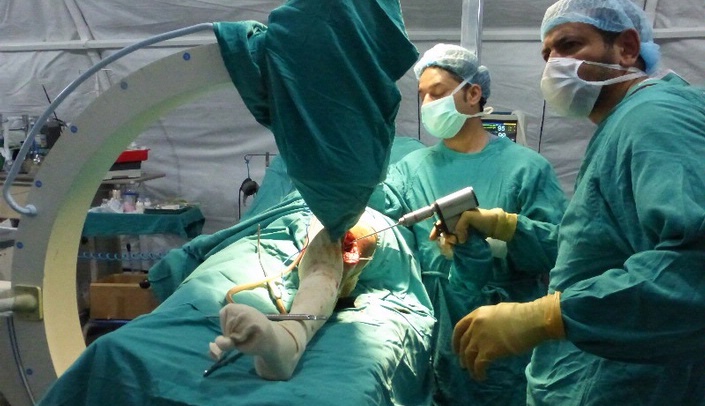Just days after a second deadly earthquake hit Nepal on May 12, Dr. Miguel Daccarett boarded a plane and flew the 7,600 miles to Kathmandu, one of the cities most affected by the devastating natural disasters.
On the morning of April 25, Nepal was crippled by the worst disaster in more than eight centuries. A violent, 7.8-magnitude earthquake struck near Kathmandu, the country’s capital, leaving entire villages flattened, thousands of people killed or injured and temples, homes and landmarks destroyed.
The rest of the world watched as the death toll continued to rise, reaching about 8,700, according to the Nepalese government.
In Omaha, UNMC leaders and staff kept a close eye on the situation in Nepal. UNMC and Nebraska Medicine formed the Nepal Disaster Relief Effort Committee to come up with an aid plan. In addition, the University of Nebraska Foundation set up the UNMC Nepal Disaster Relief Fund, which raised over $24,000 from nearly 100 donors.
But Dr. Daccarett wanted to do more.
"I received an email from Operation Walk Chicago about the Nepal Orthopedic Hospital (NOH)," Dr. Daccarett said. "I got in touch with Dr. Saju Pradhan, the hospital director in Kathmandu, and was told they needed an orthopaedic trauma surgeon immediately. So I decided to go, knowing that I could rely on my partners here to give quality care to my patients. I could not have made the trip without the department’s support."
Dr. Daccarett left Omaha May 16 and spent the next two weeks in Kathmandu, where he was put to work operating solely on earthquake victims. He performed an estimated two or three surgeries per day. Most earthquake-related injuries were long bone and periarticular fractures, he reported. As one of the few trauma surgeons at the hospital, many of Dr. Daccarett’s cases had an increased level of complexity.
"Many of the injuries I saw were up to three weeks old and had already started to heal," he said. "Sometimes I would have to re-break the bone so it could heal properly."
While he did bring useful supplies with him – wire cutters, drills, K-wires, etc. – many of the surgical instruments available were not as reliable as those in the U.S., so he was forced to improvise. Coupled with an average of three or four aftershocks per day, Dr. Daccarett described the working conditions as less-than-ideal.
"One day, I was operating on a humerus and there was a 4.2 magnitude aftershock; it shook the entire place," he said, referencing the OR tent in which he performed his surgeries. "People were very scared. After the second earthquake, nobody wanted to operate inside, so we used the tent. With each aftershock, people panicked and we had to calm them down."
In total, NOH saw more than 2,000 earthquake patients and operated on 271 people in the weeks following the disasters. According to the NOH website, the hospital provided care for over 10 percent of the injured victims – free of charge.
As a result of the hospital’s well-documented and organized handling of the earthquake aftermath, Dr. Daccarett will be able to follow up with many of his patients by monitoring their x-rays and tracking their progress.
"It is very rare to be able to monitor these distant patients," he said. "I treated many people when I volunteered in Haiti and I still have no idea who they are or how they are doing."
Dr. Daccarett is no stranger to disaster relief. A lifelong volunteer, he worked with the Red Cross in Colombia before enrolling in medical school and volunteered to help in the aftermath of the 1985 volcano eruption in Armero, Colombia. He was also in New York City in 2001, where he volunteered his help after the September 11th terrorist attack. Most recently, he made two trips to Haiti following the 2010 earthquake.
No matter where or what the situation, Dr. Daccarett said it is difficult to prepare for disasters like these.
"You have to be able to accommodate and adapt to what they need," he said. "You show up and ask what you can do to help. You give your insight if they ask but you have to be tactful."
In addition to performing surgeries, Dr. Daccarett also got a firsthand look at the destruction left behind by the quake. He spent one day with NOH employees visiting Sankhu, Bhaktapur and Lalitpur, three towns close to Kathmandu, each in varying degrees of ruin. It was an experience he won’t soon forget.
"I was on the other side of the world, working with strangers, but I came home with many new friends and a feeling of accomplishment," he said.
"When I was young, my parents and teachers taught me the importance of volunteering. I have become a man for others and hope that everyone can experience the happiness that comes from volunteering, in whatever capacity."
